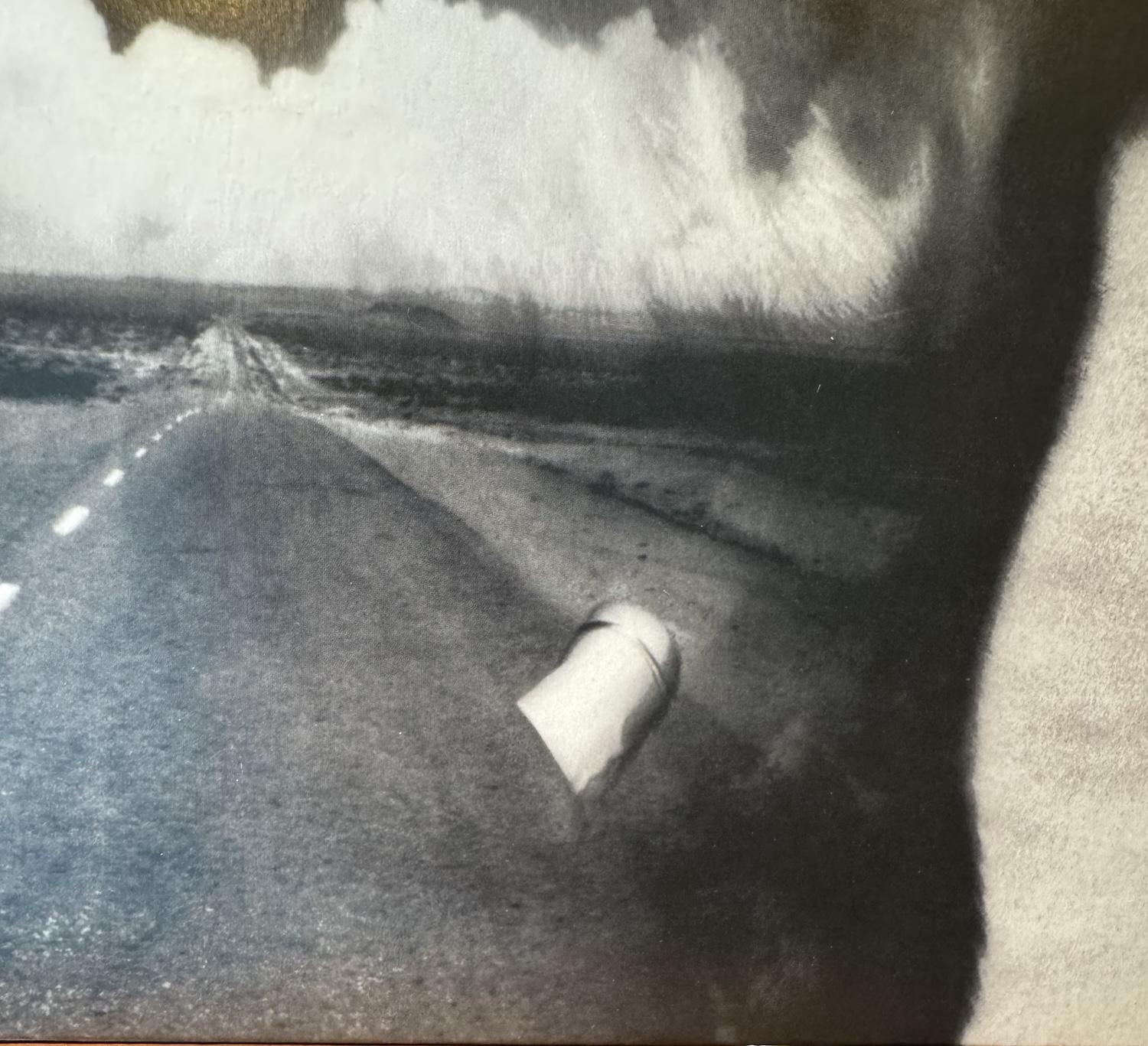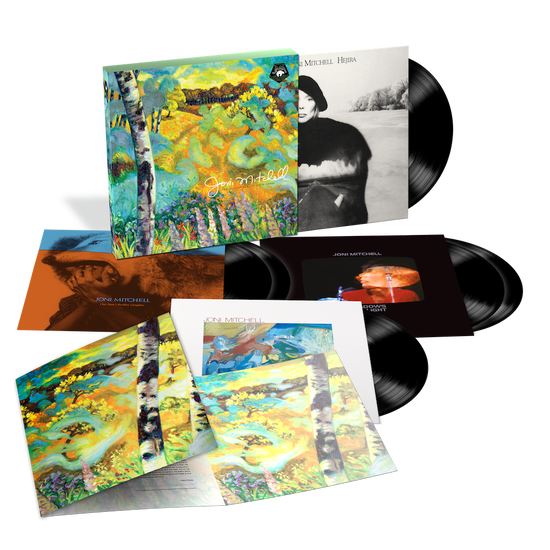Is This The Most Essential Joni Box Set Yet?
yes, please read the reasoning
On 1974's Court and Spark Joni Mitchell cautiously dipped her musical toes into the jazz pool, adding some studio players like Milt Holland, Wilton Felder and Tom Scott to the arranging mix and capping the record with a sly, startling cover of Wardell Gray and Annie Ross's "Twisted" found originally on Lambert, Hendricks & Ross!: The Hottest New Group in Jazz (Columbia CS 8198). Cheech and Chong added some of their zany comic commentary to the original's more sophisticated, high brow humor.
For Mitchell it was a radical departure in mood and musical style. Other than the raucous "Raised on Robbery", the album is mostly more of Mitchell's painful self-doubt. She wishes she had "more sense of humor" on the almost excruciating "People's Parties", leaving many fans at the time thinking "Well, that's me at a party but Joni Mitchell?". On the closer she's got more sense of humor. Hearing her light-spirited startled.
She's in the pool in The Hissing of Summer Lawns gatefold and above the image. The lyrics are densely packed thickets of words that ring from a different time and place zone than Court and Spark. The artistic growth is remarkable on every level. Mitchell knows she's leaving her audience behind, or parts of it. She writes of the album "...the whole unfolds like a mystery. It is not my intention to unravel that mystery for anyone, but rather to offer some additional clues:"
It's an album about liberation on so many levels. The cover takes you from the city to the suburbs to the jungle with songs about same. There's jazz, a drum loop spun from the warrior drums of Burundi, James Taylor, David Crosby and Victor Feldman. It's restless. She's restless and even though it charted well, that was mostly Court and Spark forward momentum. It took years for the audience to return, or mature into it. For those of us tied to the audio world it's great to see that throughout her career Mitchell unlike so many other artists was intimately involved in the sonic art behind record making, relying on the great Henry "more than an engineer" Lewy for sonic and studio spiritual advice and Bernie Grundman to see the results through to vinyl. We like that. We think it's important because it is.
During the tour with the L.A. Express she broke up with John Guerin and following a concert in Wisconsin though there was no river to skate upon, she found frozen Lake Mendota and after buying some black skates, went out on the frozen lake accompanied by photographer Joel Bernstein and that's Joni on the inside cover being the black crow she later sings about on Hejira.
Following the tour to support The Hissing of Summer Lawns, Mitchell retreated to Neil Young's place to chill out and then drove cross country with some friends over the Bi-centennial summer of 1976 and returned alone to the west coast to record the songs, some of which were written during the lonely drive during which she reflected on her "aloneness" and coming to grips with not having a family .
The cover reflects the complete Mitchell metamorphosis to defiant cigarette clutching, beret topped, fur wearing jazz chick. Her face issues a challenge as if to say, "If you don't buy this, if it looks to you like a costume or a put-on, I don't give a shit". She's got a two lane highway superimposed on her jacket with her arm poking through into her pocket, which is also the road.
When Hejira (Arabic for "a journey away from a dangerous situation") was first released there was a thing like the Batman logo where some people saw teeth and some a bat. I remember some people at the time, November of 1976, saying "Okay, but why is there a penis sticking out of the road? That's creepy!"
 That is both an infantile aside, and factual. It was a "thing" at a time when everyone was busy analyzing everything about albums from the cover art to the musical content. Moving on though to a higher plane, Hejira was and is a remarkable set of searching travel and non-committal hook-up songs. On the opener, "Coyote", she describes an affair with a cowboy who awakes to brush out a mare while she sings "I'll just be getting home with my reel to reel". She uses the Amelia Earhart story as a metaphor for her inability to take flight singing "Maybe I've never really loved, I guess that's the truth." She has an affair in New England, in the title tune, sings of hitting thirty, visiting Stan Jay's (now closed) Mandolin Brothers shop on Staten Island, comparing herself to a black crow, and taking refuge on the road. There's true liberation and in "Blue Motel", genuine negotiating: "You lay down your sneaking around the town, honey/And I'll lay down the highway."
That is both an infantile aside, and factual. It was a "thing" at a time when everyone was busy analyzing everything about albums from the cover art to the musical content. Moving on though to a higher plane, Hejira was and is a remarkable set of searching travel and non-committal hook-up songs. On the opener, "Coyote", she describes an affair with a cowboy who awakes to brush out a mare while she sings "I'll just be getting home with my reel to reel". She uses the Amelia Earhart story as a metaphor for her inability to take flight singing "Maybe I've never really loved, I guess that's the truth." She has an affair in New England, in the title tune, sings of hitting thirty, visiting Stan Jay's (now closed) Mandolin Brothers shop on Staten Island, comparing herself to a black crow, and taking refuge on the road. There's true liberation and in "Blue Motel", genuine negotiating: "You lay down your sneaking around the town, honey/And I'll lay down the highway."
Through friends she found Jaco Pastorius who overdubbed bass on four tracks and continued working with her. Shortly after the album's release, Martin Scorsese filmed "The Last Waltz" and Mitchell was there performing "Coyote", "Shadows and Light" and "Furry Sings the Blues". If you have a 4K Blu-ray player and the rest, it's a great set!
Hejira went Gold, almost made the Billboard Top 10 and got FM airplay but the hippie contingent backed away from the jazz, preferring to dwell on Blue with Court and Spark being the Mitchell end point for some.
The original pressing of Hejira (and also Court and Spark) had an annoying upper mid boost that gave it a "shouty" sound. If you played them loud enough to enjoy the "shouty" quality made you turn it down. Bernie Grundman's EQ here is so much better than the original. Also the bass was attenuated on the original and here Jaco gets a fair shake.
This is a great album that maybe you don't play because of the bum EQ or maybe at the time it was "too jazzy" for you. You'll find yourself playing this one. After listening for this review I did some research and came upon fascinating interview by a Dave Blackburn with engineer Steve Katz, who assisted Lewy in the A&M studios in which Blackburn says "I notice there is a very consistent spike at 2.8kHz on the vocal and the piano... from Ladies of the Canyon all the way through Don Juan" and Katz confirms he remembers seeing a fixed 2.8kHz setting. Clearly Bernie has distanced himself from it in this remastering, which sounds way better than the original and makes this album really sing.
I'll not go through each album in this kind of detail other than to say all of the four albums in this set (two doubles and two singles) sound way better than the originals versions—something I could not write about the previous Asylum years box set.
Mitchell's next album the self-described Don Juan's Reckless Daughter could be the best "...must produce an album to fulfill a contract" album ever recorded. Certainly the best double "...must produce an album to fulfill a contract" album ever. There were leftover songs from previous albums and some new ones, performed by previously used musicians including Jaco plus percussionist Don Alias and saxophone great Wayne Shorter.
When first released this was for me impenetrable and self-indulgent and it had that annoying 2.8kHz boost that made it less than a pleasant listen but now it sounds much better and the extended "Paprika Plains" alone makes this worth having (Shorter soars). I sat through the double discs more than a few times. The percussion instrumental "The Tenth World" would be a hi-fi show show stopper if anyone had the imagination to play it instead of "Keith Don't Go".
Charles Mingus, having heard "Paprika Plain" invited Mitchell to collaborate on some tunes and do some real jazz and though by then he was too sick to play. There's a version of "Goodbye Pork Pie Hat" with new lyrics by Mitchell that's a standout. Jaco is here, plus Shorter, Herbie Hancock, Peter Erskine, Don Alias and percussionist Emil Richards. This not Don Juan.... became the final Asylum produced album, some recorded following Mingus's passing, followed by the live album Shadows and Light that documents the tour mounted in support of the record.
There's something especially poignant about Mitchells' back cover portrait of Mingus in Mexico sitting in a wheel chair, view from the rear. Some years later it could just as easily be a Joni Mitchell self-portrait.
Andy Johns and Henry Lewy recorded Shadows and Light using The Record Plant's remote facilities at the Santa Barbara County Bowl September, 1979. It was mixed by Lewy, Mitchell and Skip Cottrell at A&M Studios. More importantly, the band was Jaco, Don Alias, Pat Metheny, Lyle Mays, Michael Brecker with The Persuasions adding their vocal specialness. What a band! Deeper grooves than the L.A. Express.
The tunes are mostly from the albums in the rest of the box set plus Frankie Lymon and The Teenagers' classic Doo Woo number "Why Do Fools Fall In Love" and the closer, "Woodstock".
The best backup band Joni Mitchell worked with, stellar recorded and mixed sound and a great mix of songs definitely not a track listing intended to please anyone but Mitchell herself, decades later this turns out to be one of the great rock/jazz recordings of the era. The sound is enveloping and sweeping, not a surprise given who's involved. An unjustly overlooked live set!
Great job by all involved in this reissue and among the three Mitchell box sets so far, this is the most successful in creating a reissue that sounds far better than the original individually available albums. If you are a fan these, you've never heard them sound so good. If you passed on Mitchell in her post Laurel Canyon adult stage, consider re-visiting these mature works. A great reissue box and highly recommended for music and sound! Plus a super-attractive slip case with Joni artwork.











































.png)








